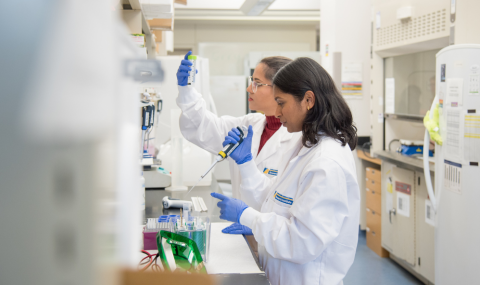- Left sided facial movement occurs when a message is sent from the right cerebral cortex (from the motor strip) crossing over to stimulate the left CN VII. Activation of CN VII causes the entire left side of the face to move.
- Bell's Palsy, or a true left CN VII paralysis causes paralysis of the entire left side of the face. This includes loss of the ability to wrinkle the left forehead on the affected side. Other symptoms include an inability to close the eyelid on the affected side, ipsilateral dryness of the eye (with risk for corneal ulceration), dryness of the mouth, and decreased sense of taste.
- Because of the close proximity to CN VIII, balance and hearing should also be assessed when the CN VII is damaged.
|
|
Facial paralysis can also occur as a result of damage to the cerebral cortex or motor nerves that carry the message to CN VII on the opposite side (Upper Motor Neuron cause). Thus, right cerebral cortex injury prevents the left CN VII from being stimulated, causing left sided facial weakness.
Forehead wrinkle is the one clinical feature that can differentiate the origin of unilateral facial weakness. The forehead muscle and most of the eyelid contraction is activated bilaterally in response to stimulation of EITHER CN VII. Bilateral eye blink is an important protective response.
If a left sided facial weakness is caused by an injury to the right cerebral cortex (e.g., stroke), the duel innervation of the forehead will result in facial weakness below the forehead, with preservation of bilateral forehead wrinkle and eyelid closure (may have mild weakness but the eye will not be "wide open".
If facial weakness is caused by a CN VII injury (a Lower Motor Neuron problem), neither side of the brain is able to activate it. The weakness will extend to include the forehead on the affected side (making it look "ironed out" on the side of the CN VII injury). Eye closure will also usually be impaired (and may be "wide open"). Examples of Lower Motor Neuron CN VII disorders include: CN VII injury due to middle fossa basal skull fracture, acoustic neuroma or Bell's Palsy.
CN VII palsy places the cornea at significant risk. Lower Motor Neuron CN VII dysfunction is the most serious as the inability to close the eye or produce tears (lacrimation) can lead to corneal ulceration if the eyes are not kept moist and closed. While mild eyelid closure problems can occur with stroke (Upper Motor Neuron problem), a "wide open lid" favors a CN VII cause versus stroke.
- ASSESSMENT OF CN VII (Motor Component)
- Conscious Patient
- Ask the patient to smile, show their teeth and close the eyes tightly. Try to open the lids to see if eye lid closure strength is equal. Ask patient to wrinkle forehead.
- Observe for symmetry of facial movement. Look closely at nasal labial fold for subtle differences. Assess for symmetry of forehead wrinkle.
- CN VII disorders can be associated with dry mouth or choking (impaired salivation or loss of sensation to anterior portion of tongue), dry eyes/corneal injury or associated symptoms involving the adjacent CN VIII (hearing and balance).
- Unconscious Patient
- Brain stem reflexes involving CN VII should be present in conscious and unconscious patients. It can be evaluated by stimulating an appropriate sensory nerve and observing for an automatic CN VII motor response. The reflex motor response tested is typically eye closure. Although we can voluntarily choose to close one eye at a time, when eye closure is triggered involuntarily through a reflex arc, CN VII is stimulated bilaterally to cause the simultaneous protection (closure) of both eyes.
- Reflex testing is done by stimulating the following sensory nerves:
- Optic Reflex:
Rapidly moving an object toward the face should cause both eyes to blink simultaneously. This tests CN II (Optic - the object was seen) and CN VII (both eyes closed for protection).
- Corneal Reflex:
Touching the edge of the lower eyelid or cornea should cause both eyes to blink. This is called the corneal reflex. It tests sensation in the area of the eye which stimulates a bilateral blink reflex. Sensation to the face is detected by CN V (Trigeminal nerve). CN V has 3 branches (V1 - eye and forehead, V 2 - maxillary and V3 - mandibular region). More specifically, the corneal reflex is an assessment of the brainstem reflex between the V1 branch of CN V (sensory) on one side, and CN VII (motor) bilaterally.
- Nasal Tickle:
A rolled up tissue can be used to irritate the nasal cavity which should cause a bilateral blink, tearing of the eyes or bilateral facial movement. This also tests the V1 branch of CN V and CN VII.
- Auditory Reflex:
A sudden loud noise (loud clapping close to patient) should cause a startle response and bilateral blink. This tests CN VIII - Aucoustic and CN VII.
|



